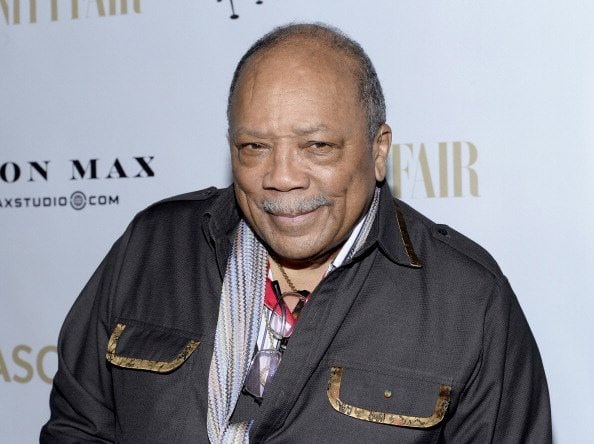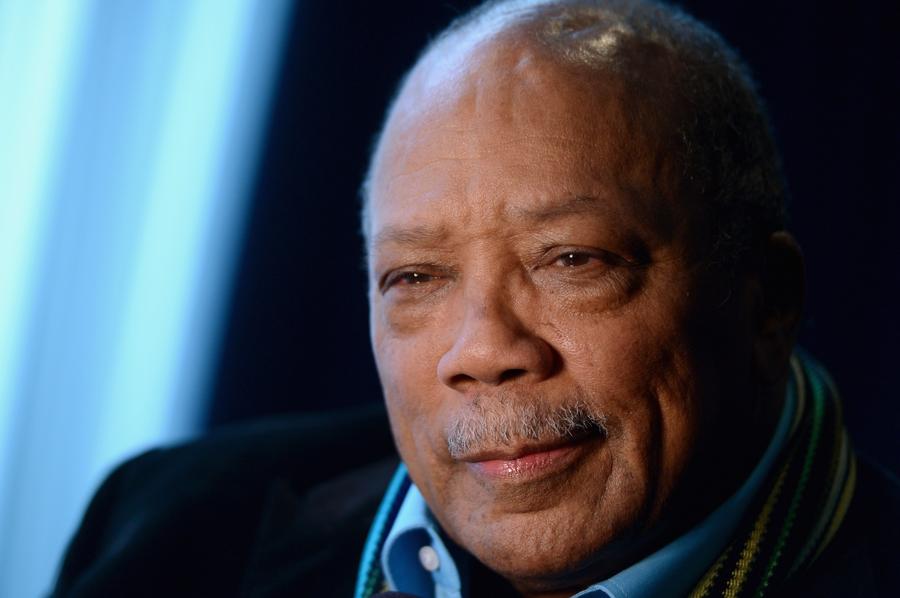What was Quincy Jones's Net Worth?
Quincy Jones was an American musical conductor, record producer, trumpeter, musical arranger, and television producer who had a net worth of $500 million at the time of his death. Quincy died on November 3, 2024, at the age of 91.
Quincy Jones was one of music's most influential figures. With a career spanning over six decades as a producer, composer, arranger, conductor, and trumpeter. His journey began in Seattle, where he learned trumpet as a teenager and began playing jazz professionally in the 1940s. In the 1950s, Jones worked as an arranger for stars like Sarah Vaughan and Ray Charles before joining Mercury Records as its first African American executive in 1961. He composed for film and television, earning Oscar and Emmy nominations for his work.
His most famous collaboration was with Michael Jackson, producing three albums including "Thriller," the best-selling album of all time. His production work with Michael Jackson alone resulted in more than 150 million records sold. Every time a Quincy Jones-produced Michael Jackson album or song is sold or played commercially, Quincy earned a royalty. He also produced Frank Sinatra, Lesley Gore, and countless other artists. His work on "We Are the World" helped raise millions for African famine relief. During his career, Jones has earned 28 Grammy Awards, including a Grammy Legend Award, and received numerous honors, including the Grammy Living Legend Award, Kennedy Center Honors, and the National Medal of Arts. He also worked as a film and TV producer, launching Will Smith's career with "The Fresh Prince of Bel-Air" and producing films like "The Color Purple."
Early Life
Quincy Delight Jones Jr. was born on March 14th, 1933. His family participated in the "Great Migration," and they relocated to Chicago when Quincy and his brother were still young. Quincy's early experiences with music were through religious songs. He also had the chance to play piano since his next-door neighbor owned one and let him practice. While Quincy was still quite young, his mother suffered a schizophrenic breakdown and was admitted to a mental hospital. His father divorced her and married again, and his new wife already had three children of her own. Later, Quincy's father and his stepmother would have three more children.
When World War 2 broke out, the family moved to Washington, where his father got a job at a naval shipyard. After the war ended, the family relocated to Seattle, where Quincy Jones attended high school. During his time in high school, he obtained a musical education, learned how to compose, and became a talented trumpet player. He soon made connections with other major jazz musicians in Seattle and introduced himself to Ray Charles as a 14-year-old.
In 1951, Quincy Jones enrolled in Seattle University with a scholarship. One of his classmates was a young Clint Eastwood. Jones spent just one semester there before transferring to Berklee College of Music in Boston. Although he continued to study while playing jazz at night at local bars, it eventually became clear to Jones that he needed to begin his professional music career.

Kevork Djansezian/Getty Images
Career
Quincy Jones moved to New York after leaving college. His talents as an arranger were soon recognized, although he was still booking gigs as a trumpet player. One of his earliest jobs was playing in a band that supported Elvis Presley's first televised appearances in 1956. After touring around the world, he started living in Paris. Eventually, he started acting as music director for Barclay, a French record company.
In 1961, Quincy Jones became vice-president of Mercury, the parent company of Barclay and a major record label in the United States. He also started composing music for motion pictures during this time, starting with The Pawnbroker. His talents for composing movie scores soon became well known, and he enjoyed a career as an extremely sought-after composer for Hollywood producers. Films such as The Italian Job, The Getaway, The Deadly Affair, and many others all feature scores composed by Quincy Jones. He also displayed a knack for writing theme songs for various TV shows such as The Bill Cosby Show, Roots, Mad TV, and many others.
During the 60s, Quincy Jones also worked with a number of musicians, acting as a composer for names such as Peggy Lee, Shirley Horn, and Frank Sinatra. Quincy Jones also worked closely with Frank Sinatra in the 70s after forming his own production company, Qwest Productions. In 1981, Quincy Jones released his own album called The Dude. Although the album bore Quincy Jones' name, it featured a wide range of artists performing songs that Jones had written or produced. The Dude ended up winning three Grammy Awards.
Michael Jackson Collaboration
Quincy Jones' partnership with Michael Jackson stands as one of the most successful producer-artist collaborations in music history, yielding three landmark albums that revolutionized popular music. Their relationship began in 1978 when they met on the set of "The Wiz," where Jones served as musical director while Jackson starred as the Scarecrow. Impressed by Jackson's drive and talent, Jones agreed to produce his first solo adult album "Off the Wall" (1979), which marked Jackson's transformation from child star to mature artist. The album sold over 20 million copies worldwide and spawned hits like "Don't Stop 'Til You Get Enough" and "Rock with You."
Their next collaboration, "Thriller" (1982), became the best-selling album of all time, moving an estimated 70 million copies globally and winning eight Grammy Awards. Jones' sophisticated production approach, blending pop, R&B, rock, and disco, helped create timeless tracks like "Billie Jean," "Beat It," and the title track. The duo completed their trilogy with "Bad" (1987), which sold over 35 million copies and made history by generating five Billboard Hot 100 #1 singles.
Throughout their collaboration, Jones' jazz background and orchestral expertise complemented Jackson's pop sensibilities and innovative dance style, creating a sophisticated sound that appealed to multiple demographics. Jones brought in top session musicians and innovative arrangements while encouraging Jackson to explore deeper themes and more complex musical structures. Their partnership went beyond typical producer-artist relationships – Jones acted as a mentor figure to Jackson, helping him realize his vision of transcending racial and genre boundaries in music. Together, they created albums that not only dominated sales charts but also revolutionized music production techniques, music video concepts, and the very way pop music was conceived and marketed. Their total album sales together exceed 150 million copies, and their influence on popular music continues to resonate decades later through countless artists who have drawn inspiration from their groundbreaking collaborations.

Kevin Winter/Getty Images
Further Ventures
Quincy Jones also found success as a film and television producer, beginning with the film "The Color Purple" in 1985. In 1990, he merged his production company with Time Warner to launch a new venture that would go on to produce several iconic television shows, including "The Fresh Prince of Bel-Air," "The Jenny Jones Show," and "Mad TV."
In 2001, he published his autobiography, "Q: The Autobiography of Quincy Jones," offering a candid look at his life and career. He later launched his own podcast in 2007.
Jones also made numerous guest appearances on television series such as "The Boondocks" and "Saturday Night Live," and had cameo roles in films including "Fantasia 2000" and "Austin Powers in Goldmember."
Personal Life
From 1957 to 1966, Quincy Jones was married to Jeri Caldwell. They had one child together during their 11-year relationship. After dating Carol Reynolds, he had another child. From 1967 to 1974, Quincy Jones was married to Ulla Andersson, a Swedish actress. They had two children together before divorcing. Quincy Jones then married Peggy Lipton, and they had two daughters together, including actress Rashida Jones, before divorcing in 1990. Jones' next wife was a German actress named Nastassja Kinski, and he had another child with her before divorcing her in 1995.
In 1974, Quincy Jones suffered a serious brain aneurysm. This caused him to decrease his workload and focus more on his family. He also started using heroin at age 15, although he quit relatively quickly after falling down a flight of stairs while inebriated. After getting into a car accident at age 14, Quincy Jones vowed never to learn how to drive.
Bel Air Mansion
In December 1986, Quincy Jones paid $3 million for a home in Bel Air—roughly $7 million in today's dollars. He sold that property in 2005 for $5.4 million after completing construction on a much larger custom-built estate, also in Bel Air.
Designed in the early 2000s and inspired by the South African hotel The Palace of the Lost City, Quincy's new 25,000-square-foot compound sits on 2.3 acres atop a promontory near Sunset Boulevard. The estate features sweeping views of the Los Angeles skyline, San Gabriel Mountains, and Pacific Ocean. It was designed by architect Gerald "Jerry" Allison, a high school friend of Jones, in collaboration with WATG.
In May 2025, the estate was listed for $59.995 million.
Key features include:
- A domed living room with floor-to-ceiling windows, a grand piano, and a built-in bar
- A private home recording studio with its own entrance, reception area, and gallery
- A wine cellar, tasting room, and "game lounge"
- A screening room and several guest suites
- An infinity-edge pool and outdoor dining area
- A full-size lighted tennis court and circular motor court
- Panoramic views of the city, mountains, and ocean
Jones designed the estate to create a clear separation between his personal life and professional work—a major shift from his previous home, where awards and file folders filled the living spaces.
Death
Quincy Jones died on November 3, 2024, at the age of 91.
/2020/02/quincy.jpg)
/2009/09/Michael-Jackson.jpg)
/2021/03/Rashida-Jones.jpg)
/2020/07/frank-sinatra.jpg)
/2009/11/Stevie-Wonder.jpg)
/2014/07/GettyImages-452250010.jpg)
/2019/11/GettyImages-1094653148.jpg)
/2018/03/GettyImages-821622848.jpg)
/2020/04/Megan-Fox.jpg)
/2017/02/GettyImages-528215436.jpg)
/2020/02/Angelina-Jolie.png)
/2009/11/George-Clooney.jpg)
/2009/09/Cristiano-Ronaldo.jpg)
/2020/01/lopez3.jpg)
/2019/04/rr.jpg)
:strip_exif()/2009/09/P-Diddy.jpg)
/2020/06/taylor.png)
/2020/02/quincy.jpg)
/2009/09/Michael-Jackson.jpg)
/2017/07/GettyImages-475154623-1.jpg)
/2017/07/GettyImages-475154623.jpg)
/2016/10/Rod-Temperton.jpg)
/2011/03/AR-Rahman.jpg)
/2012/01/Rod-Temperton.jpg)
/2009/12/dp.jpg)
/2009/09/Jennifer-Aniston.jpg)
:strip_exif()/2015/09/GettyImages-476575299.jpg)